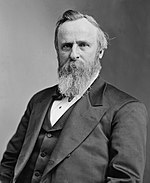Samuel Tilden 1876 presidential campaign
| Samuel Tilden for President | |
|---|---|
Samuel Tilden | |
| Affiliation | Democratic Party |
| Status | Lost general election |
The
The Democratic nomination fight


After the Democrats captured control of the
At the
Campaign
The 1876 Democratic platform demanded the repeal of the


Tilden's campaign aggressively focused on winning the crucial
Results

While both candidates went to bed on Election Night, Tuesday, Nov. 7, 1876, assuming that Tilden had won (indeed, Tilden had won the national popular vote by a 51%-48% margin), late results from the West made the election outcome unclear.[5] Tilden had won 184 electoral votes (one short of a majority) whereas 20 electoral votes (one from Oregon and 19 from the South) were disputed.[5] The dispute over the 19 electoral votes from the Southern U.S. was based on the fact that there was a dispute over who had carried the states of Louisiana, Florida, and South Carolina.[5] After some debate, a 15-member
Out of the five Supreme Court members of this commission, there were two Republicans, two Democrats, and one independent—U.S. Supreme Court Justice David Davis.[5] In an attempt to win Davis's favor, the Democratic-Greenback coalition in the new Illinois legislature appointed Davis to the U.S. Senate.[5] To their surprise, however, Davis immediately resigned from the Electoral Commission in order to take his U.S. Senate seat. Meanwhile, Davis was replaced on the Electoral Commission by Republican Joseph P. Bradley.[5]
Ultimately, the Electoral Commission voted on a partisan 8 to 7 vote to award all 20 disputed electoral votes to Hayes (with Justice Bradley being the decisive vote in all of these votes), thus allowing him to defeat Tilden and win the U.S. presidency by one electoral vote (with 185 electoral votes going to Hayes while 184 electoral votes went to Tilden).
Samuel Tilden waited until June 13, 1877, before he conceded the 1876 U.S. presidential election to Rutherford Hayes.[7]
References
- ^ a b c d e f g h "HarpWeek | Elections | 1876 Overview". Elections.harpweek.com. Retrieved 2017-09-20.
- ^ "On This Day: February 19, 1876". Nytimes.com. Retrieved 2017-09-21.
- ^ "Rutherford Hayes, James Garfield, Chester Arthur". Adamcadre.ac. Retrieved 2017-09-20.
- ^ a b "Another Look at the 1876 Election - Rutherford B. Hayes Presidential Library & Museums". Rbhayes.org. 2006-02-19. Retrieved 2017-09-21.
- ^ a b c d e f g h i j k l m n o p "HarpWeek | Elections | 1876 Overview". Elections.harpweek.com. Retrieved 2017-09-20.
- ^ "Another Look at the 1876 Election - Rutherford B. Hayes Presidential Library & Museums". Rbhayes.org. 2006-02-19. Retrieved 2017-09-21.
- ^ "1876 Presidential Concession Speech - Rutherford B. Hayes Presidential Library & Museums". Rbhayes.org. 2016-11-22. Retrieved 2017-09-21.
